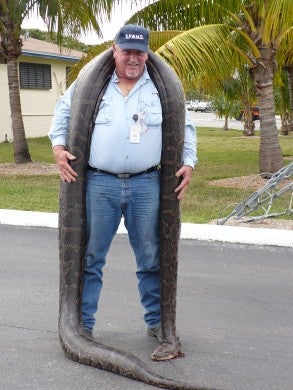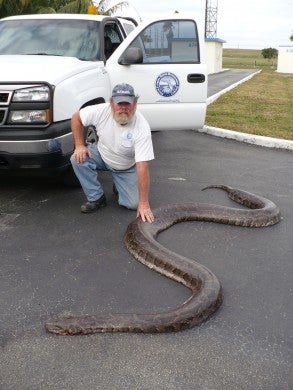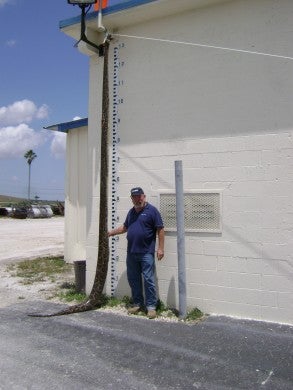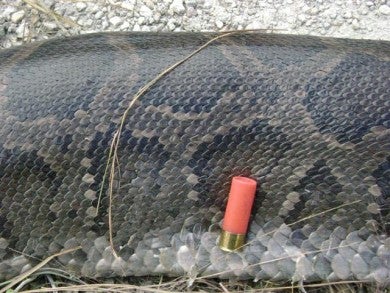Python Problems in Paradise
Bob McNally 09.28.15
)
Some experts say that as many as 150,000 wild pythons are crawling around in South Florida, chiefly in and around Everglades National Park. But viable breeding populations of pythons extend well into the Florida Keys, according to LeRoy Rodgers, a scientist with the South Florida Water Management District (SFWMD) and the agency point man dealing with invasive species.
Even more disconcerting, says Rodgers, is the fact that the remarkably adaptable python is capable of greatly expanding its range in the U.S.. Burmese pythons could potentially spread far up the Atlantic Seaboard to Washington D.C., along the entire Gulf Coast, through Texas, on into New Mexico, Arizona, and California.
Burmese pythons are so big, bold, and abundant in South Florida that many outdoorsmen say they have greatly reduced native small mammal and bird populations in the area. Anglers and hunters who for years have driven before sunrise and after dark across Alligator Alley and the Tamiami Trail, now report seeing almost no rabbits, raccoons, opossums, and other small wildlife species that in years past were commonly observed.
South Florida wildlife authorities are so alarmed at the booming python population that some people have suggested placing a bounty on the snakes–something not done to control an invasive species in Florida in recent memory.
South Florida pythons are so prolific and are so dramatically impacting native species, that the SFWMD and even the Humane Society of the United States have petitioned the U.S. Fish and Wildlife Service to discontinue the legal importation of large constrictor snakes like Burmese pythons, also including boas and anacondas.
These large and fast-growing snakes are popular pets in the U.S. (over 1 million imported from 2002 to 2006). However, when such snakes get too large for pet owners to handle, they often are released into the wild.
Since no zoos or nature centers want the constrictors, invasive and potentially dangerous wild pythons are being shot by SFWMD personal. Long-time South Florida outdoorsman and hunter Bob Hill is a structure maintenance technician for the SFWMD. Because he is afield daily mowing and maintaining the area’s extensive levee system, Hill has likely dealt with more pythons than anyone. He has special authority to shoot pythons and collect road kill snakes, which are turned over to scientists at Everglades National Park for necropsy to learn more about the non-native species that has so taken over Florida habitat.
“We don’t enjoying having to kill Burmese pythons, but it’s something that must be done because they are killing native animals,” says LeRoy Rodgers. “Pythons are beautiful, but they are so big, and there are so many in Florida, they must be euthanized.”
Since 2004, Bob Hill has helped remove hundreds of large pythons from South Florida. It’s unknown how many other snakes have been dispatched by farmers and outdoorsmen without being reported. And these are only the pythons most easily seen and found on farm fields, roads, and mowed-grass levees.
How many snakes live in the wild outback of the Everglades and South Florida is anyone’s guess.



